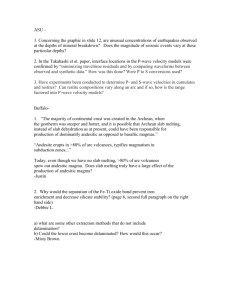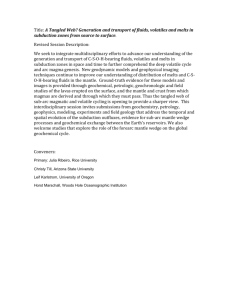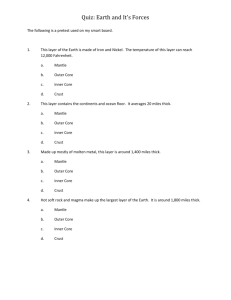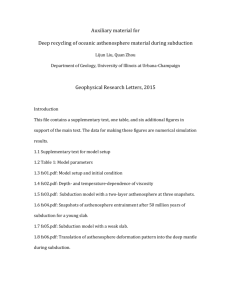Chapter 16- Island Arcs
advertisement
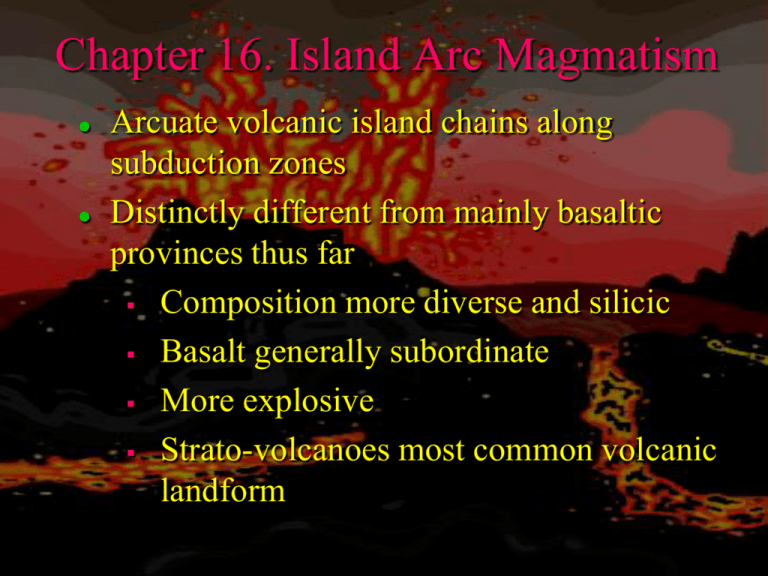
Chapter 16. Island Arc Magmatism Arcuate volcanic island chains along subduction zones Distinctly different from mainly basaltic provinces thus far Composition more diverse and silicic Basalt generally subordinate More explosive Strato-volcanoes most common volcanic landform Igneous activity related to convergent plate situations- subduction of one plate beneath another The initial petrologic model: Subducted oceanic crust is partially melted Partial melts- more silicic than source Melts rise through the overriding plate volcanoes just behind leading plate edge Unlimited supply of oceanic crust to melt This simple elegant model fails to explain many aspects of subduction magmatism The Subduction Factory From Tatsumi, Y. (2005) The subduction factory: How it operates in the evolving Earth. GSA Today, 15, 4-10. Ocean-ocean Island Arc (IA) Ocean-continent Continental Arc or Active Continental Margin (ACM) Figure 16.1. Principal subduction zones associated with orogenic volcanism and plutonism. Triangles are on the overriding plate. PBS = Papuan-Bismarck-Solomon-New Hebrides arc. After Wilson (1989) Igneous Petrogenesis, Allen Unwin/Kluwer. Subduction Products Characteristic igneous associations Distinctive patterns of metamorphism Orogeny and mountain belts Complexly Interrelated Structure of an Island Arc Figure 16.2. Schematic cross section through a typical island arc after Gill (1981), Orogenic Andesites and Plate Tectonics. Springer-Verlag. HFU= heat flow unit (4.2 x 10-6 joules/cm2/sec) Volcanic Rocks of Island Arcs Complex tectonic situation and broad spectrum of volcanic products High proportion of basaltic andesite and andesite Most andesites occur in subduction zone settings Table 16-1. Relative Proportions of Analyzed Island Arc Volcanic Rock Types Locality B B-A A D R 2 Mt. Misery, Antilles (lavas) 17 22 49 12 0 2 Ave. Antilles 17 ( 42 ) 39 2 1 Lesser Antilles 71 22 5 ( 3 ) 1 Nicaragua/NW Costa Rica 64 33 3 1 0 1 W Panama/SE Costa Rica 34 49 16 0 0 1 Aleutians E of Adak 55 36 9 0 0 1 Aleutians, Adak & W 18 27 41 14 0 2 Little Sitkin Island, Aleutians 0 78 4 18 0 2 Ave. Japan (lava, ash falls) 14 ( 85 ) 2 0 1 Isu-Bonin/Mariana 47 36 15 1 <1 1 Kuriles 34 38 25 3 <1 2 Talasea, Papua 9 23 55 9 4 1 Scotia 65 33 3 0 0 1 from Kelemen (2003a and personal comunication). 2 after Gill (1981, Table 4.4) B = basalt B-A = basaltic andesite A = andesite, D = dacite, R = rhyolite Basalts are still very common and important! Major Elements and Magma Series Tholeiitic (MORB, OIT) Alkaline (OIA) Calc-Alkaline (~ restricted to SZ) Characteristic Plate Margin Series Convergent Divergent Alkaline yes Tholeiitic yes yes Calc-alkaline yes Within Plate Oceanic Continental yes yes yes yes Major Elements and Magma Series a. Alkali vs. silica b. AFM c. FeO*/MgO vs. silica diagrams for 1946 analyses from ~ 30 island and continental arcs with emphasis on the more primitive volcanics Figure 16.3. Data compiled by Terry Plank (Plank and Langmuir, 1988) Earth Planet. Sci. Lett., 90, 349-370. Figure 16.4 The three andesite series of Gill (1981). A fourth very high K shoshonite series is rare. Contours represent the concentration of 2500 analyses of andesites stored in the large data file RKOC76 (Carnegie Institute of Washington). Figure 16.6. a. K2O-SiO2 diagram distinguishing high-K, medium-K and low-K series. Large squares = high-K, stars = med.-K, diamonds = low-K series from Table 16-2. Smaller symbols are identified in the caption. Differentiation within a series (presumably dominated by fractional crystallization) is indicated by the arrow. Different primary magmas (to the left) are distinguished by vertical variations in K2O at low SiO2. After Gill, 1981, Orogenic Andesites and Plate Tectonics. Springer-Verlag. Figure 16.6. b. AFM diagram distinguishing tholeiitic and calc-alkaline series. Arrows represent differentiation trends within a series. Figure 16.6. c. FeO*/MgO vs. SiO2 diagram distinguishing tholeiitic and calc-alkaline series. The gray arrow near the bottom is the progressive fractional melting trend under hydrous conditions of Grove et al. (2003). 6 sub-series if combine tholeiite and C-A (some are rare) May choose 3 most common: • Low-K tholeiitic • Med-K C-A • Hi-K mixed Figure 16.5. Combined K2O - FeO*/MgO diagram in which the Low-K to High-K series are combined with the tholeiitic vs. calcalkaline types, resulting in six andesite series, after Gill (1981) Orogenic Andesites and Plate Tectonics. Springer-Verlag. The points represent the analyses in the appendix of Gill (1981). Tholeiitic vs. Calc-alkaline differentiation Figure 16.7. From Winter (2001) An Introduction to Igneous and Metamorphic Petrology. Prentice Hall. Calc-alkaline differentiation Early crystallization of Fe-Ti oxide Probably related to the high water content of calcalkaline magmas in arcs, dissolves high fO2 High PH2O also depresses plagioclase liquidus more An-rich As hydrous magma rises, DP plagioclase liquidus moves to higher T crystallization of considerable Anrich-SiO2-poor plagioclase The crystallization of anorthitic plagioclase and lowsilica, high-Fe hornblende may be an alternative mechanism for the observed calc-alkaline differentiation trend Other Trends Spatial “K-h”: low-K tholeiite near trench C-A alkaline as depth to seismic zone increases Some along-arc as well Antilles more alkaline N S Aleutians is segmented with C-A prevalent in segments and tholeiite prevalent at ends Temporal Early tholeiitic later C-A and often latest alkaline is common REEs Trace Elements Slope within series is similar, but height varies with FX due to removal of Ol, Plag, and Pyx (+) slope of low-K DM Some even more depleted than MORB! Others have more normal slopes heterogeneous mantle sources HREE flat, so no deep garnet Figure 16.10. REE diagrams for some representative Low-K (tholeiitic), Medium-K (calc-alkaline), and High-K basaltic andesites and andesites. An N-MORB is included for reference (from Sun and McDonough, 1989). After Gill (1981) Orogenic Andesites and Plate Tectonics. Springer-Verlag. MORB-normalized Spider diagrams Intraplate OIB has typical hump Figure 14.3. Winter (2001) An Introduction to Igneous and Metamorphic Petrology. Prentice Hall. Data from Sun and McDonough (1989) In A. D. Saunders and M. J. Norry (eds.), Magmatism in the Ocean Basins. Geol. Soc. London Spec. Publ., 42. pp. 313-345. MORB-normalized Spider diagrams IA: decoupled HFS - LIL (LIL are hydrophilic) What is it about subduction zone setting that causes fluid-assisted enrichment? Figure 14.3. Winter (2001) An Introduction to Igneous and Metamorphic Petrology. Prentice Hall. Data from Sun and McDonough (1989) In A. D. Saunders and M. J. Norry (eds.), Magmatism in the Ocean Basins. Geol. Soc. London Spec. Publ., 42. pp. 313-345. Figure 16-11a. MORB-normalized spider diagrams for selected island arc basalts. Using the normalization and ordering scheme of Pearce (1983) with LIL on the left and HFS on the right and compatibility increasing outward from Ba-Th. Data from BVTP. Composite OIB from Fig 14-3 in yellow. Isotopes New Britain, Marianas, Aleutians, and South Sandwich volcanics plot within a surprisingly limited range of DM Figure 16.12. Nd-Sr isotopic variation in some island arc volcanics. MORB and mantle array from Figures 13-11 and 10-15. After Wilson (1989), Arculus and Powell (1986), Gill (1981), and McCulloch et al. (1994). Atlantic sediment data from White et al. (1985). Pb is quite scarce in the mantle • Low-Pb mantle-derived melts susceptible to Pb contamination • U, Pb, and Th are concentrated in continental crust (high radiogenic daughter Pb isotopes) • 204Pb non-radiogenic: 208Pb/204Pb, 207Pb/204Pb, and 206Pb/204Pb increase as U and Th decay • Oceanic crust also has elevated U and Th content (compared to the mantle) • Sediments derived from oceanic and continental crust • Pb is a sensitive measure of crustal (including sediment) components in mantle isotopic systems • 93.7% of natural U is 238U, so 206Pb/204Pb will be most sensitive to a crustal-enriched component 9-20 9-21 9-22 234U 206Pb 235U 207Pb 232Th 208Pb 238U H I M U Figure 16.13. Variation in 207Pb/204Pb vs. 206Pb/204Pb for oceanic island arc volcanics. Included are the isotopic reservoirs and the Northern Hemisphere Reference Line (NHRL) proposed in Chapter 14. The geochron represents the mutual evolution of 207Pb/204Pb and 206Pb/204Pb in a single-stage homogeneous reservoir. Data sources listed in Wilson (1989). 10Be created by cosmic rays + oxygen and nitrogen in upper atmos. • Earth by precipitation • Readily clay-rich oceanic sediments • Half-life of only 1.5 Ma • Long enough to be subducted After about 10 Ma 10Be is no longer detectable Not a part of main mantle systems 10Be/9Be averages about 5000 x 10-11 in the uppermost oceanic sediments • In mantle-derived MORB and OIB magmas, & continental crust, 10Be is below detection limits (<1 x 106 atom/g) and 10Be/9Be is <5 x 10-14 Boron is a stable element • Very brief residence time deep in subduction zones • B in recent sediments is high (50-150 ppm), but has a greater affinity for altered oceanic crust (10-300 ppm) • In MORB and OIB it rarely exceeds 2-3 ppm 10Be/Be total vs. B/Betotal diagram (Betotal 9Be because 10Be so rare) Figure 16.14. 10Be/Be(total) vs. B/Be for six arcs. After Morris (1989) Carnegie Inst. of Washington Yearb., 88, 111-123. Petrogenesis of Island Arc Magmas Why is subduction zone magmatism a paradox? Main variables that can affect the isotherms in subduction zone systems: 1) Rate of subduction 2) Age of subduction zone 3) Age of subducting slab 4) Extent to which subducting slab induces flow in the mantle wedge 5) Effects of frictional shear heating along W-B zone Other factors, such as: • Dip of slab • Endothermic metamorphic reactions • Metamorphic fluid flow are now thought to play only a minor role Typical thermal model for a subduction zone Isotherms will be higher (i.e. the system will be hotter) if a) Convergence rate is slower b) Subducted slab is young and near the ridge (warmer) c) Arc is young (< 50-100 Ma according to Peacock, 1991) yellow curves = mantle flow Figure 16.15. Cross section of a subduction zone showing isotherms (red-after Furukawa, 1993, J. Geophys. Res., 98, 83098319) and mantle flow lines (yellow- after Tatsumi and Eggins, 1995, Subduction Zone Magmatism. Blackwell. Oxford). The principal source components IA magmas 1. Crustal portion of the subducted slab 1a Altered oceanic crust (hydrated by circulating seawater, and metamorphosed in large part to greenschist facies) 1b Subducted oceanic and forearc sediments 1c Seawater trapped in pore spaces Figure 16.15. Cross section of a subduction zone showing isotherms (red-after Furukawa, 1993, J. Geophys. Res., 98, 83098319) and mantle flow lines (yellow- after Tatsumi and Eggins, 1995, Subduction Zone Magmatism. Blackwell. Oxford). The principal source components IA magmas 2. Mantle wedge between slab and arc crust 3. Arc crust 4. Lithospheric mantle of subducting plate 5. Asthenosphere beneath slab Figure 16.15. Cross section of a subduction zone showing isotherms (red-after Furukawa, 1993, J. Geophys. Res., 98, 83098319) and mantle flow lines (yellow- after Tatsumi and Eggins, 1995, Subduction Zone Magmatism. Blackwell. Oxford). Left with the subducted crust and mantle wedge Trace element and isotopic data both contribute to arc magmatism. How, and to what extent? Dry peridotite solidus too high LIL/HFS ratios of arc magmas water plays a significant role in arc magmatism Sequence of pressures and temperatures a rock subjected to during burial, subduction, metamorphism, uplift, etc. is called a pressure-temperature-time (P-T-t) path P-T-t paths for subducted crust Based on subduction rate of 3 cm/yr (length of each curve = ~15 Ma) Subducted Crust Yellow paths = various arc ages Red paths = different ages of subducted slab Figure 16.16. Subducted crust pressure-temperature-time (P-Tt) paths for various situations of arc age (yellow curves) and age of subducted lithosphere (red curves, for a mature ca. 50 Ma old arc) assuming a subduction rate of 3 cm/yr (Peacock, 1991, Phil. Trans. Roy. Soc. London, 335, 341-353). Add solidi for dry and water-saturated melting of basalt and dehydration curves of likely hydrous phases Subducted Crust Figure 16.16. Subducted crust pressure-temperature-time (P-Tt) paths for various situations of arc age (yellow curves) and age of subducted lithosphere (red curves, for a mature ca. 50 Ma old arc) assuming a subduction rate of 3 cm/yr (Peacock, 1991). Included are some pertinent reaction curves, including the wet and dry basalt solidi (Figure 7-20), the dehydration of hornblende (Lambert and Wyllie, 1968, 1970, 1972), chlorite + quartz (Delaney and Helgeson, 1978). Winter (2001). An Introduction to Igneous and Metamorphic Petrology. Prentice Hall. Mature arcs (lithosphere > 25 Ma): Dehydration D releases water in No slab melting! Slab melting M in arcs subducting young lithosphere. Dehydration of chlorite or amphibole releases water above the wet solidus (Mg-rich) andesites directly. Subducted Crust Newer models allow for temperature and stress dependence of mantle wedge viscosity. Indicates much higher temperatures in the shallowest part of the subducted slab. Figure 16.17. P-T-t paths at a depth of 7 km into the slab (subscript = 1) and at the slab/mantle-wedge interface (subscript = 2) predicted by several published dynamic models of fairly rapid subduction (9-10 cm/yr). ME= Molnar and England’s (1992) analytical solution with no wedge convection. PW = Peacock and Wang (1999) isoviscous numeric model. vK = van Keken et al. (2002a) isoviscous remodel of PW with improved resolution. vKT = van Keken et al. (2002a) model with non-Newtonian temperature- and stress-dependent wedge viscosity. After van Keken et al. (2002a) © AGU with permission. Subducted Crust Slab melting in mature arcs no longer precluded by models. Debate renewed. LIL/HFS trace element data underscore the importance of slab-derived water and a MORB-like mantle wedge source Flat HREE pattern argues against a garnetbearing (eclogite) source Modern opinion has swung toward the nonmelted slab for most cases Mantle Wedge P-T-t Paths Amphibole-bearing hydrated peridotite should melt at ~ 120 km Phlogopite-bearing hydrated peridotite should melt at ~ 200 km second arc behind first? Figure 16.19. Calculated P-T-t paths for peridotite in the mantle wedge as it follows paths similar to the flow lines in Fig 16.15. Included are dehydration curves for serpentine, talc, pargasite, and phlogopite + diopside + orthopyroxene. Also the P-T-t path range for the subducted crust in a mature arc, and the wet and dry solidi for peridotite. Subducted crust dehydrates, and water is transferred to the wedge (labeled arrows). Areas in which the dehydration curves are crossed by the P-T-t paths below the wet solidus for peridotite are stippled and labeled D for dehydration. Areas in which the dehydration curves are crossed above the wet solidus are hatched and labeled M for melting. Note that although the slab crust usually dehydrates, the wedge peridotite melts as pargasite dehydrates (Millhollen et al., 1974) above the wet solidus. An alternative model involves dehydration of serpentine chlorite nearer the wedge tip (lower-case d) with H2O rising into hotter portions of the wedge (gray arrow) until H2O-exess solidus is crossed (lowercase m). A second melting may also occur as phlogopite dehydrates in the presence of two pyroxenes (Sudo, 1988). After Peacock (1991), Tatsumi and Eggins (1995). Winter (2001). An Introduction to Igneous and Metamorphic Petrology. Prentice Hall. Crust and Mantle Wedge Island Arc Petrogenesis Figure 16.18. A proposed model for subduction zone magmatism with particular reference to island arcs. Dehydration of slab crust causes hydration of the mantle (violet), which undergoes partial melting as amphibole (A) and phlogopite (B) dehydrate. From Tatsumi (1989), J. Geophys. Res., 94, 4697-4707 and Tatsumi and Eggins (1995). Subduction Zone Magmatism. Blackwell. Oxford. A multi-stage, multi-source process Mantle wedge HFS and other depleted and compatible element characteristics Slab dehydration (and perhaps melting) LIL, 10Be, B, etc. enrichments + enriched Nd, Sr, and Pb isotopic signatures These components, plus other dissolved silicate materials, are transferred to the wedge in a fluid phase (or melt in some cases?) Phlogopite is stable beyond amphibole breakdown Wedge P-T-t paths reach phlogopite dehydration at ~ 200 km depth Fractional crystallization takes place at a number of levels From Peacock (2003) Geophysical Monograph 138 Am. Geophys. Union

